Nerve Plant (Fittonia Plant): Caring for Vein Plants
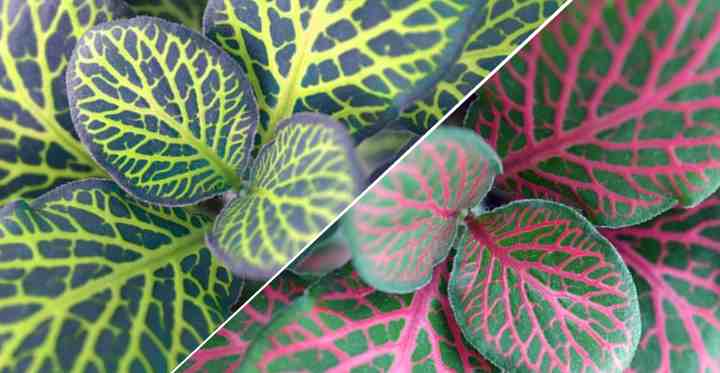
Fittonia plants are beautiful tropical houseplants that have patterned leaves with pink, red, light green or white veins. These colorful patterns contrast well on the dark green leaves. Due to the intricate veined patterning, fittonias are also called nerve plants, vein plants, mosaic plants, and painted net plants. The attraction of nerve plants is that they are easy to grow in the home and help to brighten up any room.
Fittonia plants have the scientific name Fittonia albivenis and belong to the family of tropical plants Acanthaceae. These flowering tropical plants are native to rainforests in South America. All types of fittonias are from the same botanical family as polka dot plants. Nerve plants grow well at room temperature and are ideally suited for the home environment.
How to care for nerve plant: the fittonia plant thrives when growing in well-draining moist potting soil rich in organic matter, temperature range between 60 and 80°F (16 – 26°C), medium light away from direct sunlight, and plenty of humidity. Feed your nerve plants once a month or every other month during spring and summer.
Some types of fittonia plants, such as the ‘Juanita’ nerve plant, have broad leaves with bright red veins. Nerve plant cultivars such as the ‘Red Anne’ or ‘White Anne’ have smaller leaves with white or pinkish-red veins. Other popular nerve plant cultivars include ‘Mini Superba,’ ‘Pink Angel,’ and the ‘Purple Vein’ nerve plant. The mosaic patterns on some types of nerve plants almost turn the dark green leaves a brighter red or white color.
Fittonia plants have high ornamental value and grow well in containers on your windowsill, in hanging baskets, or terrariums. If you live in warmer climates, you can also grow nerve plants outdoors.
In this article, you will learn how to care for nerve plants and how to keep them healthy and free from disease.
Nerve Plant (Fittonia) Care Summary
Nerve plants thrive in indirect sunlight or partial shade and need to grow in well-draining soil. The best environment for healthy growth is a temperature range between 60 and 80°F (16 – 26°C).

Nerve plants require high humidity and indirect light
Although vein plants are easy to care for, there are a few requirements to keep the leaves vibrant and healthy. The two main factors to consider when caring for a nerve plant are light and moisture.
Because they are tropical rainforest plants, species of Fittonia albivenis need high humidity and moist soil. You can help to increase the humidity by misting the veined leaves regularly.
How to Care for Nerve Plants
Let’s look in more detail at the best way to care for ornamental fittonia houseplants.
Lighting Requirements for Nerve Plants
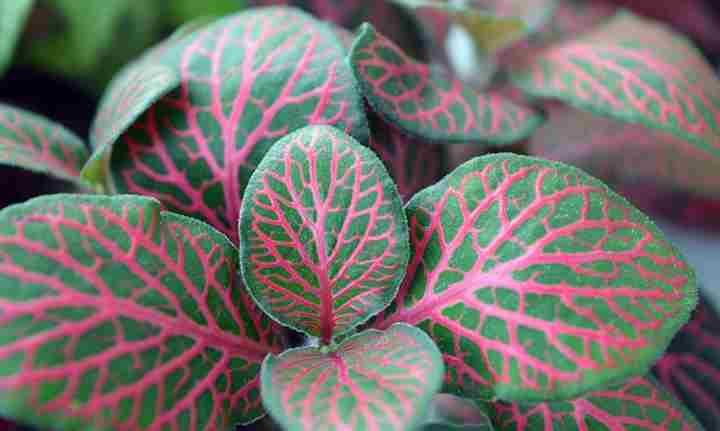
Place fittonia plants away from direct sunlight
Fittonia nerve plants thrive when they grow in low to medium light environments. In the wild, nerve plants grow on the ground in rainforests, where sunlight is minimal.
The best places for growing vein plants are on a north-facing windowsill, behind sheer curtains, or in a bright spot away from direct sunlight.
One sign that your nerve plant is getting too much sun is if the leaves show signs of burning. So, if you notice your nerve plant’s leaves have brown patches, are crispy, or start to wither, move it to a location away from sunlight.
Nerve Plant (Mosaic Plant) Soil Requirements
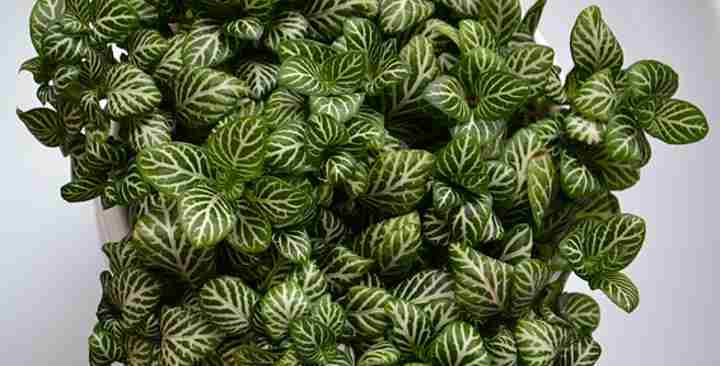
Vein plants grow well in moist soil that is well draining
To keep your nerve plant growing well, it should be in well-draining, moist soil. This type of soil is similar to the tropical environment where mosaic plants grow in their native environment.
The best way to get the best soil for a nerve plant is to ensure it is rich in organic matter. This type of potting mixture helps to hold enough moisture without becoming soggy. Suitable soil types for fittonias include peat-based soil or loamy potting soil.
The container for your nerve plant should allow water to drain out at the bottom. This is an essential growing requirement when it comes to watering your nerve plant.
How to Water Your Nerve Plant (Fittonia)
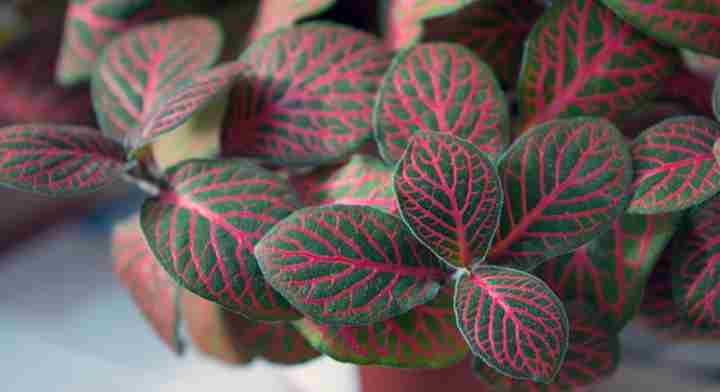
Overwatering fittonia nerve plant can cause root rot
Nerve plants need constant moisture in the soil if they are to thrive indoors. The most common mistake when caring for nerve plants is to let the soil dry out.
How can you know when the best time to water your fittonia is? The optimal time to water your vein plant is when the top layer of soil has just become dry. Water it enough so that water starts to drain out the bottom of the container.
Remember that room temperature will affect how quickly the soil dries out. So, if your room is warm, you may have to water your fittonia every other day.
It’s also important to remember that too much water can lead to root rot. So, avoid letting your fittonia sit in water. Also, don’t have your pot sitting on a saucer of water.
Another care tip for nerve plants is always to use water that is at room temperature. Watering with tepid water prevents “shocking” your delicate houseplant with cold water.
One sign that you are overwatering your fittonia is if the leaves wilt and become yellow. The best fittonia plant care advice is to repot your nerve plant and prune off any damaged roots. To prevent leaf damage or weak plant growth, make sure that the soil is only ever moist, not too dry or too soggy.
Proper Humidity for Nerve Plant Care
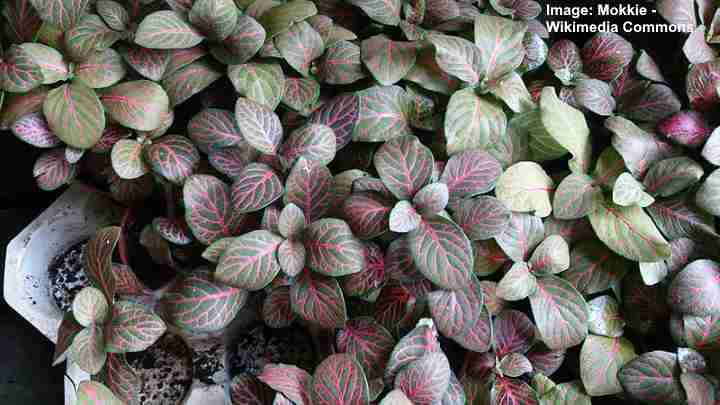
Nerve plants require high humidity
Being a native rainforest plant, nerve plants need plenty of humidity. In the home environment, misting the plant is the best way to increase humidity. High moisture levels will keep the pink, red, or white veins looking vibrant and the leaves dark green.
One way to tell if your nerve plant is lacking humidity is when the leaves start to droop. Usually, misting the leaves will quickly revive your tropical house plant.
Another way to make sure that your tropical nerve plant gets enough humidity is to use a humidifier. This method is especially useful if you need to care for many tropical houseplants. Humidifiers are also helpful in winter when the household heating tends to dry the air.
However, you don’t have to splash out on a humidifier to care for nerve plants. A simple way to create a humid environment for your vein plant is to set it on a pebble tray filled with water. Just remember to make sure that the soil doesn’t absorb water.
Terrariums also help to create the perfect conditions for your nerve plant to grow colorful foliage and brightly-patterned leaves.
Nerve Plant (Fittonia) Temperature
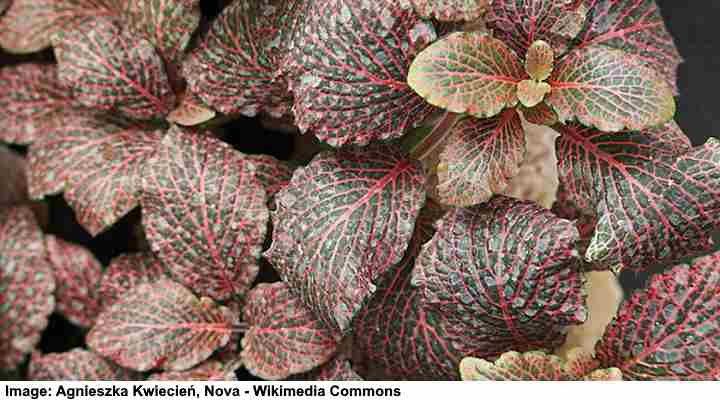
In the picture: Fittonia albivenis ‘Juanita’
All types of nerve plants such as ‘Juanita,’ ‘Red Anne’ plants, ‘White Brocade,’ and other fittonia cultivars need the right temperature. Thankfully, you don’t need to turn your home into a hot, humid place. Nerve plants grow well in typical room temperatures.
The ideal temperature for your fittonia plants is between 60 and 80°F (16 – 26°C). Keeping your nerve plants out of direct sunlight in shady conditions also helps to ensure that they grow at an even temperature.
Another care tip for fittonias is to keep them out of cold drafts. If the temperature is too cold, you may notice that the houseplant’s leaves start dropping. If this happens, move your plant to a warmer location. However, don’t put it beside a heater because it could cause the soil to dry out and your vein plant could start to wilt quickly.
Nerve Plant Feeding Requirements
To care properly for any type of fittonia plant, you will need to fertilize it occasionally. A regular houseplant fertilizer has enough nutrients to keep your indoor plants growing well. Feed your vein nerve plants once a month or every other month during spring and summer.
In late fall and winter, you can stop feeding your plant because growth is only minimal.
As with many houseplants, a buildup of mineral salts can damage your plants. To prevent this, always flush the soil with water between feedings.
One sign that you are feeding your nerve plant too much is leaf burn. If you notice brown patches appearing on the mosaic or veined leaves, water the plant thoroughly and allow all the excess water to drain. Flushing the soil should help to reduce the buildup of salts.
Mosaic Plant (Nerve Plant) Pruning
Regularly pruning your mosaic plant helps to care for healthy growth and a bushier, more lush appearance. The most crucial pruning tip for fittonias is to pinch off the ends of growing stems. This type of pruning helps prevent legginess and results in an attractive and colorful houseplant.
Some people also advise removing flower spikes. Although nerve plants produce flowers, these are inconspicuous compared to their dark green leaves with colorful veins. Pinching off flowers helps to concentrate growth in the lush foliage.
Of course, if you prefer, you can allow your nerve plant to flower.
Nerve Plant (Fittonia) Repotting
Your nerve plant will also benefit from repotting every one or two years. Replacing the soil, trimming back roots, or repotting them in a larger container all help your fittonia to grow well.
There are two reasons for re-potting your nerve plant. One is to help control growth by pruning the roots. The other is to help your fittonia grow larger by putting it in a larger container.
If you are growing your fittonia in a terrarium, you may want to repot it every year. Gently remove the plant from the container and shake off excess soil. Prune back roots by about 1” to 1.5” (2.5 – 4 cm). Use organic-rich potting soil and repot your nerve plant in its small container.
If you want a small nerve plant to grow larger, you should avoid trimming back the roots when repotting. Choose a container that is slightly larger than the current one. Ensure that the plant’s soil is well-draining, and your new pot has a drainage hole on the bottom. You could also put a layer of clay pebbles at the bottom of the container to help water flow easier through the soil.
Varieties of Nerve Plants (Fittonia)

In the picture: White Anne nerve plants
There are many types of Fittonia albivenis plants to choose from. All fittonia cultivars have lush, glossy green leaves. But it is the intricate vein patterns in different red, pink, light green or white colors that set the different varieties apart.
Nerve plant leaves are ovate shaped with a pointed tip. Some varieties of nerve plants have elongated tips and other types have lanceolate-shaped leaves.
Generally, nerve plant varieties are divided into two groups. The leafy plants with white veins are in the Argyroneura group, and fittonia plants with red or pink veins are in the Verschaffeltii group.
Here are a few of the most popular nerve plants.
- White Anne nerve plants have dark green leaves and pronounced white-veined patterns.
- Juanita vein plant is a fittonia cultivar with large leaves and bold red patterns running through the leaves.
- Pink Angel nerve plant is a showy, yet compact fittonia with bright pink and green leafy foliage. It is perfect for adding a dash of color to any room.
- Black Star and Pink Star nerve plants have wavy leaves with bold veins running across the leaf surface. The Black Star fittonia has thread-like patterns that are reddish-purple, giving the plant a dark appearance.
- Frankie fittonia plants are delightful pink houseplants. The pink vein patterns are so dense that the leaves look pure pink with green edging.
- Superba nerve plants. As the name suggests, these fittonia cultivars have large, showy leaves that look “superb.” The vein patterns are clearly seen and the veins are a crisp white color. These nerve plants grow up to 8” (20 cm) tall.
Small miniature fittonia plants only grow to between 3” and 6” (7.5 – 15 cm) tall. The larger types of nerve (vein) plants grow to between 12” and 18” (30 – 45 cm) tall.
Nerve Plant, Mosaic Plant, Juanita Plant Flowers
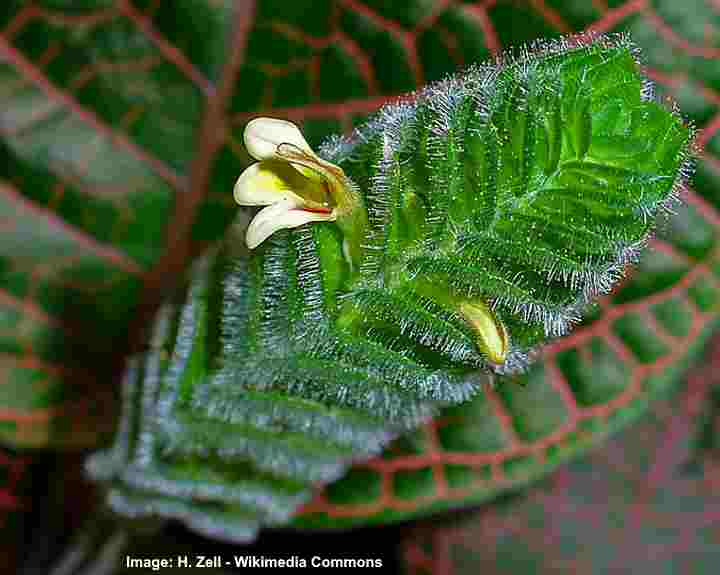
Flower of fittonia plant
Fittonia is a genus of tropical flowering plant; however, its beautiful leaves are the star attraction, not the flowers. Under the right growing conditions, your fittonia will blossom with small flowers.
What do nerve plant flowers look like? The tiny flowers bloom on small spikes. The flowers can be a white or light pink color. Because nerve plant leaves are also green and pink, it can be difficult to notice the insignificant flowers.
To properly care for a nerve plant, most people pinch off the flower spikes as soon as they appear. Pruning the flowers helps direct all the nutrients to the variegated leaves and encourages healthy leaf growth.
Are Nerve Plants Toxic?
No. Nerve plants are not toxic to pets or humans.
Nerve Plant Propagation
One of the great things about having nerve plants as house plants is that they are easy to propagate. All you need is a few cuttings if you want to grow more of these tropical houseplants. The best time to propagate your beautiful fittonia plants is in spring or early summer when growth is fastest.
To get nerve plant cuttings, cut the stems so there are at least two nodes on the stem. The nodes are the part of the stem where the leaves are joined. Remove the lower leaves.
Once you have cuttings, you can either place them directly in moist potting soil or put them in water. After about 2 or 3 weeks, you should notice that they start producing roots.
Nerve Plant Pests and Diseases
In general, nerve plants are not prone to diseases or pests. They are hardy houseplants that thrive in typical room temperatures and moist soil. Regularly misting the leaves helps to ensure a healthy nerve plant.
Pests that can affect nerve plants include mealy bugs, aphids, and thrips. If you notice any mites around your fittonia plant, it is best to isolate it from other plants to prevent the bugs from spreading.
There are several reasons why your nerve plant could look as if it is dying. Wilting leaves, brown leaf spots, or shriveled leaves are often due to the plant’s growing environment. Make sure your plant is not in direct sunlight and the soil is neither soggy nor dry.
Related articles:
